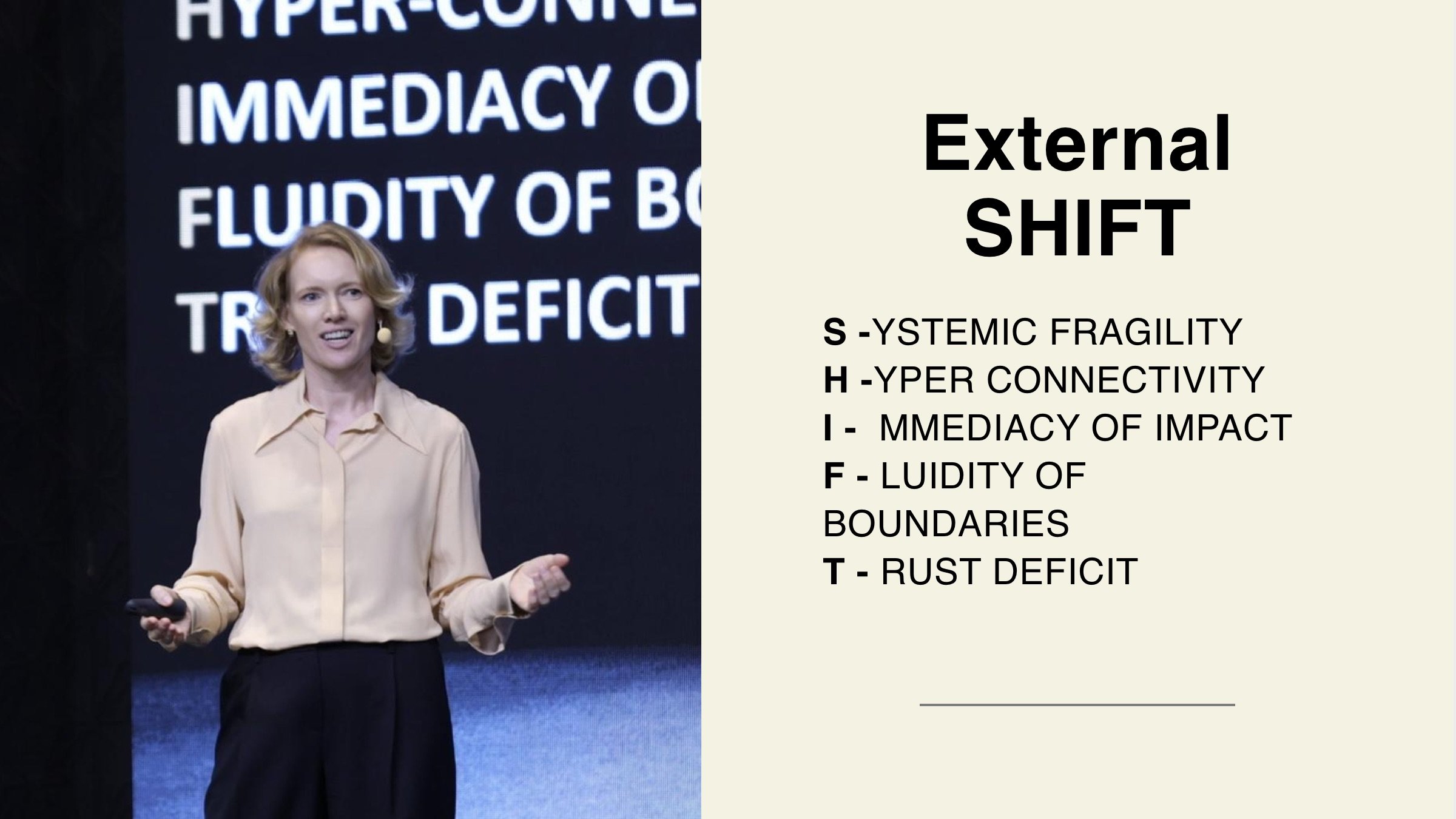How to lead in a SHIFTing world?
The Decade of Disruption: What’s Changing?
The next ten years will be the most disruptive we’ve ever seen. The pace of change has accelerated, and both external forces and internal dynamics are reshaping our organizations, our well-being, and our leadership approaches. I’ve distilled these changes into two key frameworks under the acronym SHIFT.
External SHIFT
S -ystemic fragility
H -yper connectivity
I- mmediacy of impact
F - luidity of boundaries
T - rust deficit
External SHIFT World: Navigating the New Normal
Systemic Fragility. Our world has become delicate, where even minor disruptions can have significant impacts. We’ve seen how interconnected and vulnerable our systems are, especially during the Covid-19 pandemic, whether it’s supply chains or global health. For instance, the 2020 supply chain disruption affected 75% of companies, highlighting the fragility of critical systems in the face of unexpected challenges.
Hyper-Connectivity. We’re more connected than ever, but it comes at a price. Digital overload affects 56% of employees, leading to fatigue, stress, and burnout as the boundaries between work and life blur. A Deloitte survey found that 77% of professionals have experienced burnout in their current roles, with hyper-connectivity as a contributing factor.
Immediacy of Impact. Feedback and opinions now move at lightning speed, thanks to social media and digital platforms. Studies show that 73% of executives feel under constant pressure to respond to feedback immediately, while 88% believe that reputational risks are higher today than five years ago, driven by the immediacy of online discourse.
Fluidity of Boundaries. The traditional boundaries between work and personal life have dissolved. Interestingly, more men (38%) than women (30%) report that their personal lives suffer due to work demands. Additionally, remote work has intensified this challenge, with 54% of employees reporting they feel 'always on' and unable to disconnect from work.
Trust Deficit. Trust, once broken, is difficult to rebuild. Scandals and breaches have left both employees and customers wary, making trust a critical component for leaders to focus on. Surveys reveal that 58% of employees do not trust their senior leaders, while 54% of customers are more likely to distrust organizations with poor reputations, making trust-building a critical priority for leadership today.
Internal SHIFT World: Challenges within organisations
Stressors. The increasing demands on employees create significant stress, affecting mental and physical well-being. Half of employees world-wide reporting feeling stressed at work while Google search for “burnout” has reached 5 year peak.
High Workload. Many organizations expect more from fewer people, leading to unsustainable workloads. 70% of C-suite executives said they're seriously considering leaving their companies in favor of a role that better supports their well-being.
Interpersonal Conflict. Tensions and misunderstandings between team members can derail progress and create a toxic environment. Research shows that employees spend up to 8 hours per month on gossip, much of it stemming from unresolved workplace conflicts, emphasizing the need for proactive conflict management.
Financial Stress. Financial pressures add another layer of strain for employees, exacerbated by leaders who fail to understand or address their needs. Surveys reveal that 64% of employees rely on their leaders for guidance during times of change, yet many leaders lack the skills to provide adequate support. This disconnect leaves employees feeling unsupported and disillusioned.
Toxic cultures. Internally, a lack of trust in leadership can erode employee engagement and retention. Toxic cultures are the number one reason employees leave organizations, with research showing that employees are 10 times more likely to quit due to toxic work environments than other factors like compensation.
What Can We Do About It? A Shift in Mindset
The answer lies in our ability to shift our perspective. The way we view the world, and the lens through which we interpret events, determines how we react. We often see things only from our own perspective, which can create communication breakdowns and feelings of being unheard or unimportant.
We need to become more adaptive, shifting between personal needs, team needs, and organizational needs. This flexibility is a choice, and our ability to adapt is directly tied to our capacity for growth.
Change = Choice = Courage
Embracing it is what will allow us to expand in our roles—whether as a co-worker, a CEO, or a line employee. If we don’t do the inner work as leaders to expand our ability to make conscious choices, we limit our potential to drive systemic change.
The key question for leaders is: How can we grow and adapt to create the positive shifts our organizations need?
Human-Centered Leadership: The Way Forward
To navigate these shifts without burning out, we must embrace human-centered leadership. This approach focuses on aligning organizational purpose with individual fulfillment, fostering a culture of well-being, emotional intelligence, and authentic connection.
In the coming weeks and months, I’ll be working closely with leaders during company offsite meetings and workshops to dive deeper into these principles. We’ll explore strategies for building emotionally intelligent teams and aligning the company’s purpose with what truly matters to employees. After all, today’s employees aren’t just looking for a paycheck—they’re seeking meaning and fulfillment in their work.
That's it for this time. I look forward to hearing from you, connecting with you, and sharing more insights with you.




